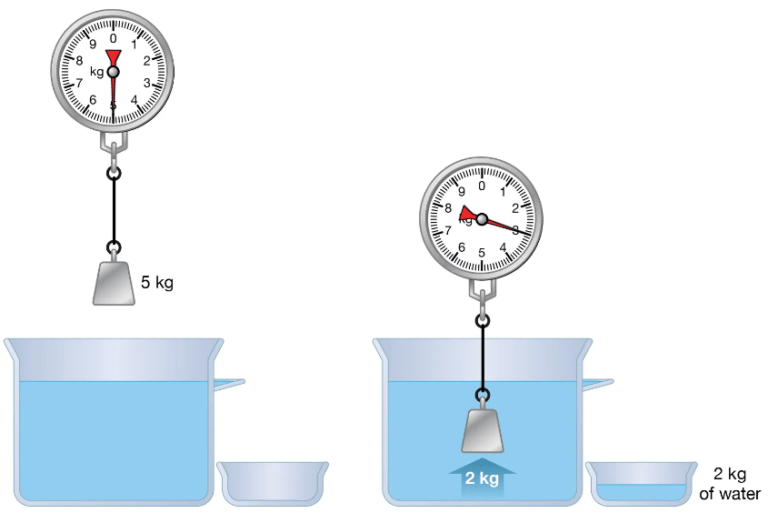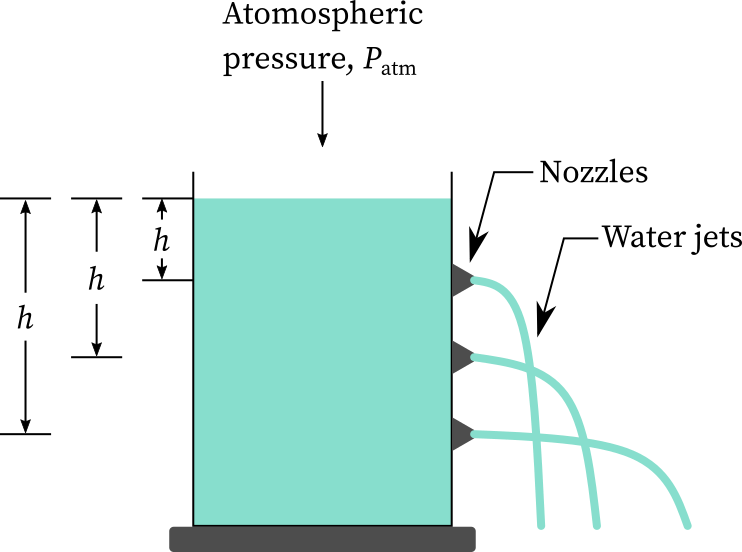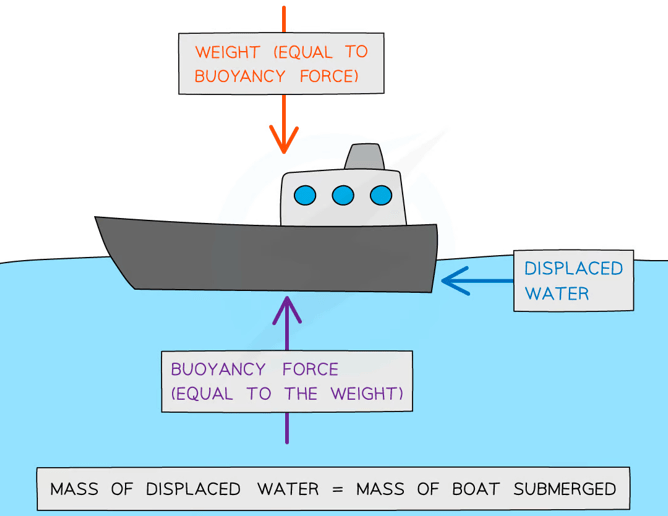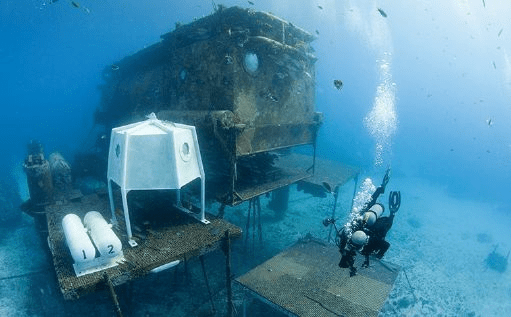Aziz Hawaldar –
Archimedes of Syracuse (287-212 BC) was a Greek mathematician, physicist, engineer, inventor, and astronomer. He is considered one of the greatest mathematicians of all time and made key contributions to the fields of mathematics, physics, and engineering. He is famous for his works on buoyancy and the principle named after him, known as Archimedes’ principle.
Archimedes’ principle of buoyancy states that an item submerged in a fluid experiences a buoyant force equal to the weight of the fluid that the object has displaced. In other words, the amount of fluid that an object pushes aside, or displaces, is equal to the force exerted by the fluid that keeps the object afloat.

For example, if we submerge a metal block in water, the block will remove a specific amount of water. The block’s weight is equal to the weight of the water it has displaced. Blocks that are heavy than the water they move will sink, while those that are lighter will float. The weight of the water displaced, which is the buoyant force acting on the block, is equal to the upward force applied to it by the water.
In the study of fluid mechanics, Archimedes’ principle is also applied to determine a fluid’s pressure at a specific depth. The principle states that a fluid’s pressure at a given depth is inversely proportional to the weight of the fluid above it. The relationship is described by the equation P = ρgh, where P denotes pressure, ρ denotes fluid density, g denotes gravitational acceleration, and h denotes fluid depth.

This theory is said to have been discovered by Archimedes as he was taking a bath and noted that the water level raised as he entered the bathtub. Eventually, he understood that this was happening because his body was displacing its weight in water. Then, while running around the streets in his underwear, he shouted “Eureka!” (Greek for “I have found it!”).

Archimedes first described the concept of buoyancy in his work “On Floating Bodies” through a famous experiment in which he determined the purity of King Hiero’s crown. According to the legend, King Hiero wanted Archimedes to find out the density of the crown because he thought his goldsmith had tricked him by choosing a less expensive metal. Archimedes poured water into a tub, submerged the crown, and watched as the water level increased. The density of the crown was then determined by weighing the crown and the water it had displaced. He was able to demonstrate that the crown was not made of pure gold by comparing this density to the known density of the gold.
The measuring of an object’s density is a common use of Archimedes’ principle of buoyancy. It is feasible to calculate an object’s density by measuring its buoyant force. The density of an object can be determined, for instance, by dividing its buoyant force by the amount of fluid it displaces when it is submerged in a fluid and its buoyant force is measured.
The design of ships is another important area where Archimedes’ principle of buoyancy is applied. The buoyant force of a ship is equal to the weight of the fluid it displaces when it is floating on the surface of a fluid. This implies that the buoyant force will increase as the volume of fluid the ship displaces increases. Engineers must consider the density of the fluid the ship will be floating in, as well as the weight of the ship and its cargo, to calculate the size and shape of the ship.

Archimedes’ Principle is also used in the aerospace industry to calculate the fuel consumption and thrust needed for a specific flight, as well as the lift and stability of aircraft.
Archimedes’ principle has significant effects on submarine design as well. When a submarine is on the surface, it is made to move a lot of water, which makes it float. As they descend, less water is displaced, which causes the submarine to sink. Understanding the buoyancy principles and controlling the amount of water the submarine displaces will help you manage the depth of the sub.
The construction of the diving bell, which is a rigid chamber used to transport divers from the surface to depth and back in open water, also takes into account the principle of buoyancy. A diving bell may stay afloat by using air to push the water around it, thanks to the buoyancy principle. Given that air is less dense than water, the diving bell will remain afloat because its buoyant force is equivalent to the weight of the water it displaces.
The design of underwater habitats, like the Aquarius Reef Base, where scientists and divers explore the ocean, also makes advantage of the principle of buoyancy. Engineers can predict the size, form, and amount of ballast the habitat will require to stay stable underwater by taking into account the buoyant force of the habitat.

The study of fluid dynamics, or the study of how fluids move and behave, is another area where the principle of buoyancy is used in practice. Fluids can be either gaseous or liquid and can have several different physical characteristics, such as viscosity, pressure, and density. The behavior of fluids in containers, such as tanks and pipes, is described by Archimedes’ principle of buoyancy, which also helps us to understand how the forces acting on the fluids cause them to move. This information is applied in a variety of industries, including the chemical, petrochemical, and oil and gas sectors, where fluid flow is essential to the manufacture and processing of goods.
Numerous industrial applications, such as the creation of tanks and other liquid storage containers, also make use of the rule of buoyancy. Engineers can choose the size and shape of a container that will keep it from toppling over even when it is filled with a dense liquid by knowing the principles of buoyancy.
In the field of civil engineering, Archimedes’ principle of buoyancy is used to calculate the weight of materials used in construction, such as concrete and steel. The rule is also used to construct retaining walls that sustain the weight of the soil and assess the stability of soil slopes.
Archimedes’ principle has several uses in the medical field. For instance, it is used to measure the volume of fluid in different medical devices, such as blood bags and IV bags, and to calculate the volume of fluid in a patient’s body. To make prosthetics like artificial limbs and legs pleasant and useful, it is also incorporated into their design. Additionally, it is used to calculate the amount of fluid required to create the desired size and shape of implants, such as breast implants.
Archimedes’ principle is utilized in environmental research to examine the stability and buoyancy of floating items like oil spills and aquatic plants. The effects of these objects on the environment, particularly those on water currents, tides, and ecology, are then ascertained using this knowledge.
Archimedes’ principle of buoyancy is also used in the design of water treatment systems, where it is used to calculate the volume of water that needs to be removed to achieve the desired level of purification.
Through various tests and observations over the years, Archimedes’ principle of buoyancy has been proven to be accurate, and it continues to be one of the most important concepts in the scientific field. The concept holds for things of any size and form, and it has been demonstrated to be correct in a variety of fluids, including air, water, and other liquids.
However, there are some limitations to this principle:
-
The fluid must be incompressible: Archimedes’ principle assumes that the fluid is incompressible, which means that its volume does not change with pressure. This could not always be the case, especially since the volume of liquids like gases might fluctuate.
-
The object must be homogeneous: The assumption made by the principle is that the thing is homogenous, meaning that its density is constant throughout. An object’s buoyancy will be impacted if different areas of it have differing densities.
-
The fluid must be still: The assumption made by the principle is that the fluid is motionless, hence there is no fluid movement. The buoyancy of the object will change if the fluid is moving.
-
The gravity of the fluid: According to the principle, the fluid should experience the same gravitational pull as the object. Its buoyancy will be impacted if the fluid is in a gravitational field that is different from the item.
Yet Archimedes’ principle has proven to be a valuable tool in our understanding of the behavior of fluids and its impact on the objects within them. It remains an essential concept in the field of physics and continues to inspire new research and discoveries.



